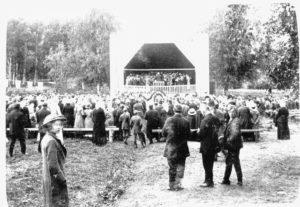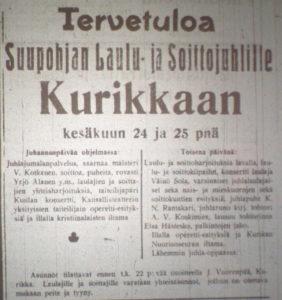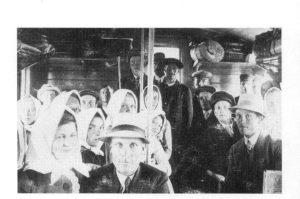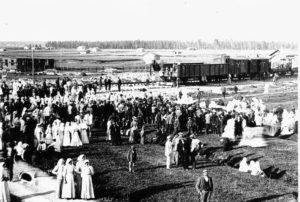Suupohja
The leader of the project called Suupohja asked more than ten years ago: “What exactly is Suupohja, as guests from other parts of Finland are always asking about it”. Sirkka Paikkala from the Institute for the Languages of Finland replied in 2003 as follows: The earliest records of the name Suupohja stem from the beginning of the 1870s, when its authenticity was disputed by the linguist August Ahlqvist (Kieletär magazine 1871 and 1872) and Yrjö Koskinen (Kirjallinen Kuukauslehti magazine 1871, p. 306). Ahlqvist claimed the name was invented by Koskinen, and Koskinen, in turn, explained that he heard it somewhere in Satakunta: “The word Suupohja is somewhat common in those parts of Satakunta, through which the old Ostrobothnian road to the rest of Finland passes.” Since then, it has been mentioned in the newspaper Satakunnan Kansa (7 March 1971, Aatos O. Ylänkö). Academician Gustav Vilkuna was interviewed for the article, and according to him, “the concept of Suupohja was not actually born until around the turn of the century (19th and 20th centuries). There was a battle for the names Suupohja and South Ostrobothnia for a while. Particularly in Northern Finland, and especially in Central Ostrobothnia, there was a long period of uncertainty about what constitutes Suupohja and what South Ostrobothnia. Gradually, the name Suupohja became established in the area between Kristinestad and Ilamajoki. However, it remained a vague concept for quite some time.” Vilkuna assumed the Northern Quark that is called “the throat of the sea” in Finnish laid the base for the word Suupohja (which translates approximately as mouth bottom) as “a throat is always followed by a mouth”. In the same article, Professor Armas Luukko reminisces that it was invented by Yrjö Koskinen. M. Sc. Esko Kansanaho from Vaasa County Regional Plan Association defined the area in 1971: “Suupohja is not an exact statistical name for an area. The area of Suupohja is located in the southern part of Ostrobothnia, partly on the coast and bordered by Satakunta. This area includes the municipalities between Ylimarku, Närpiö, and Siipyy in the Swedish regions, and at least Teuva, Kauhajoki, Kauppala in Kurikka, Karijoki, and Isojoki in the Finnish region. In this regard, Ilmajoki and Jalasjärvi can also be included. The cities of Kristinestad and Kaskinen are considered part of Suupohja.” The Handbook of Finland of 1968 defined the name as follows: “The name used for the southern part of South Ostrobothnia, centred on Kristinestad and Kaskinen.” Subsequently, the dictionaries refer to Suupohja as “the name used for the south-western part of South Ostrobothnia.” Based on the above, the area refers to the southern part of South Ostrobothnia, and the name would have been recorded at the end of the 19th century. As a slightly imprecisely defined region, it is natural that it has not been recorded in the documents in a way that allows the name to be traced in a more precise manner.
Suupohja and the Finnish nationalist movement.
The Finnish nationalist movement, Fennomania, gave rise to the Finnish-language newspaper. Two of the small newspapers took the name Suupohja, which made the name even more well-known. In the 1880s, Suupohjan Työmies (Suupohja’s Workman) was published in Vaasa for a short time, and in 1897, Suupohjan Kaiku (Suupohja’s Echo), in Kristinestad, was first published. The name emphasised the distinctive identity of the Finnish-speaking region of Southern Ostrobothnia. After all, it was the era of a fierce battle of languages. In the middle of the first period of oppression in the summer of 1904, the journalist of Suupohjan Kaiku, I. Partanen, had an idea to raise greater interest in establishing a school by means of a celebration for the people. Suupohja’s vast Finnish region had been left without a secondary school. The newspaper Suupohjan Kaiku was a key contributor to the development of the region’s Finnish-speaking culture, for example, in establishing Suupohja’s song, music, and sports celebrations, and in establishing the Kristinestad Secondary School.
Suupohja song, music, and sports festival
Reporter Partanen’s proposal for a folk party received the support of the general public. Many associations, such as youth clubs and temperance societies, held annual summer celebrations and events at which music had a long tradition. Suupohja’s song, music, and sports hobbies were then combined at such popular festivals. The National Society of Kristinestad was the first executive bodythat started organising the festivals. Suupohja’s first song, music, and sports festival was organised in Kristinestad on Midsummer 1905. A raffle had been organised in connection with the Kristinestad song festival, and during the festival, a meeting about establishing a school was held. The actual decision to establish a Finnish-language mixed secondary school in Kristinestad had already been made on 6 June 1905 at the Karijoki Youth Observatory. The school began its activities at the beginning of the autumn semester in 1906.

Suupohja’s second song, music, and sports festival was held in Karijoki on Midsummer 1906, and it hosted a meeting of citizens attending the mixed secondary school, among others. The following festivals took place in Kauhajoki 1907, Teuva 1908, Isojoki 1909, Kristina 1910, Karijoki 1912, Kauhajoki 1914, and Kurikka.
The above organisers were regular attendees at the Suupohja song, music, and sports festivals, but other people could also participate in the festivals. Singers and musicians from Ilmajoki, Seinäjoki, Karvia, and Lapua attended the Kauhajoki festival in 1907. The participants also included sports and gymnastics teams from Ilmajoki and a gymnastics team from Lapua.
Speakers at song and music festivals were usually local influences. As the festivals raised money for the Kristinestad mixed secondary school, the speeches were usually about the importance of Finnish-speaking school and culture.
The financial result varied greatly because, for example, the raffle was banned before the seventh festival held in Karijoki from 24 to 25 June 1912. Regardless of this, the song, music, and sports festivals were of great importance in Suupohja’s cultural and educational history. While supporting and promoting the region’s first Finnish secondary school, the festival promoted young people’s musical hobbies and gradually starting sports activities. Their background was influenced by youth clubs and temperance societies, many teachers, and Finnish national enthusiasm. Legislation also had a role to play. Because it was forbidden to have dances alone, some kind of programme was always organised first – then it was followed by an hour of dancing.

“Suupohja’s ninth song and music festival” was held in the Kurikka Youth Clubhouse on Midsummer 1916. It was the last one. An attempt was made to relaunch the festival after the First World War in 1920, but the attempt was unsuccessful. The festival was gradually replaced by fundraising events that included music and songs that covered the whole of South Ostrobothnia.
Suupohja’s gymnastics and sports district
Initially, Suupohja’s celebrations catered for both the spirit and the body, but in spring 1913, a gymnastics and sports district was established. In addition to the previous Isojoki, Karijoki, Kauhajoki, Kristina, Kurikka, and Teuva, also Jalasjärvi, Kaskinen, and Lapväärtti were included in the events. The following year, Suupohja’s song and music festival and sports festival were held at different times and places. The song and music festival was held in Kauhajoki at the end of June. The athletes’ festival was supposed to take place on 1 and 2 August in Kristinestad, but the competition was cancelled, as the next day, on the first day of August 1914, the First World War began.

Activities in the Suupohja gymnastics and athletics district were slowing down, so that in November 1921, a decision was made to close it. In cooperation with the Vaasa district, sports clubs were established the South Ostrobothnia district, which began operations the following spring. In addition to sports clubs, the defence associations also started organising sports competitions and exercises in the 1920s – and they also formed a Suupohja district. It included Teuva, Kristiina, Karijoki, Isojoki, and Kauhajoki.
The so-called Suupohja district
Suupohja youth clubs established their own district in 1908, which included Kauhajoki, Teuva, Karijoki, Isojoki, and Lapväärtti. At least in 1914, it held a sports a competition in Jurva, which apparently was also considered part of the Suupohja region. According to the Kauhajoki youth club, the operations of the Suupohja district remained weak.
Other information about old Suupohja
In addition to singing, music, and sports, different parts of Suupohja joined forces, for example, to establish a railway. Everyone wanted to have the railway pass their own front door, but eventually in the early 20th century, the residents had to learn to pull together, and the Suupohja railway was officially opened for traffic in 1913. Suupohja farmer’s school also awarded its benefactors its name: in addition to Kauhajoki, Karvia, Isojoki, Jurva, Lapua, and Ilmajoki granted loans and subsidies to fund constructions. Thus, the original Kauhajoki farmer’s school became Suupohja farmer’s school, even though the school’s management consisted entirely of Kauhajoki residents.

Author Liisa Ruismäki’s Juttu was first published in 2014 on the suupohja.fi website.
Suupohja today
Suupohja is a region formed by municipalities in the southern part of South Ostrobothnia, where municipalities work in cooperation and the services are mutually supportive. Geographically, the area includes Kauhajoki, Karijoki, Teuva, and Isojoki. The joint tourist website, Visit Suupohja, also covers the Kurikka area. This new travel website, Visit Suupohja, which bears a more international name, was preceded by the Seikkaile Suupohjassa (Explore Suupohja) website. Sources: Aro, Tauno: Kauhajoki Youth Club 50 years of history from 1895–1945. Vaasa 1946. pp. 30, 34 Hietalahti, Rita: The summer song festival revived the old tradition. Kauhajoki Christmas 2003. p. 11. Lauri Järvinen: The 100-year-old Kauhajoki bear is alive and kicking. Ylivieska 2010, pp. 48–57, 74–75. Kallio, Reino: The rise of a new civilization. History of South Ostrobothnia V. Vaasa 1988, pp. 96–98, 150–151. Levä, Kimmo: Kauhajoki bear. Vaasa 1990, pp. 11–12, 23–24. Paikkala, Sirkka: Institute for the Languages of Finland. Bulletin, 6 February 2003. I. Rantala: Kristinestad co-educational lyceum 1906–1956. Stages of the past five decades. Vaasa 1956. pp. 5–10. Ruismäki, Liisa: Kauhajoki history. Jyväskylä 1987. pp. 684-688, pp. 692–702. Salokangas, Raimo: Residents of South Ostrobothnia and politics. History of South Ostrobothnia VI. Vaasa. pp. 784–788, 832–833 Suupohja’s third song, music, and sports festival in Kauhajoki, 30 June and 1 July 1907. Bulletin and programmes. At the National Printing House in Kristinestad in 1907. Keijo Jaakola’s collection. Suupohjan Kehittämisyhdistys ry. The Board of Directors’ Annual Report 2013. 2.3.1. Virtanen, Harri: Bulletin, 1 August 2014 Ilkka, 14 July 1914, 24 April 1920, 14 July 1921, 18 August 1921 Vaasa, 30 March 1912, 18 April 1916 www.google.fi Current users of the name Suupohja

